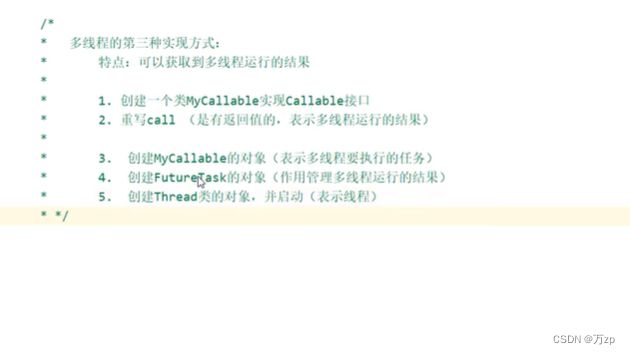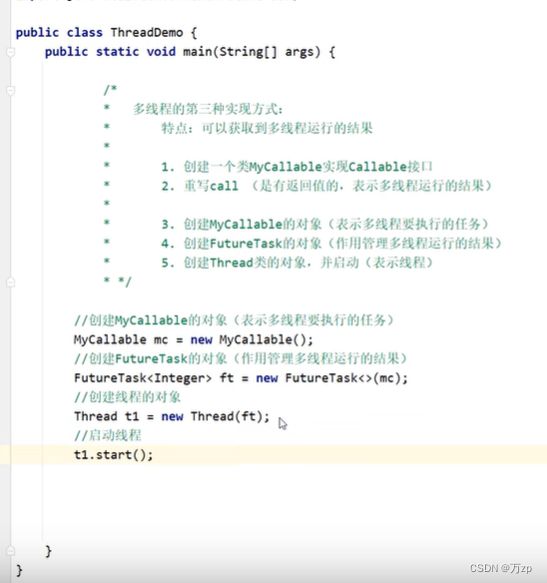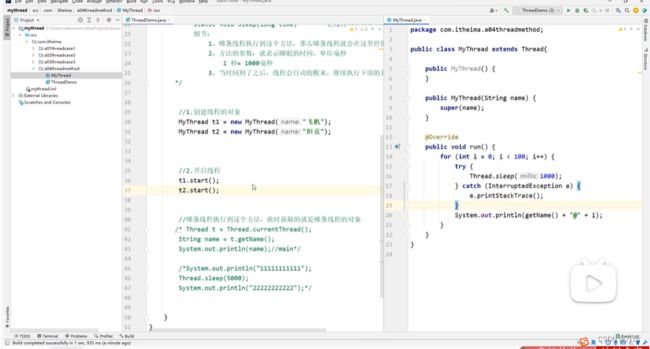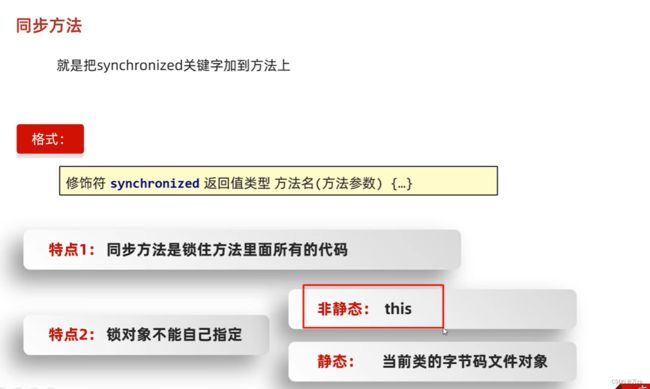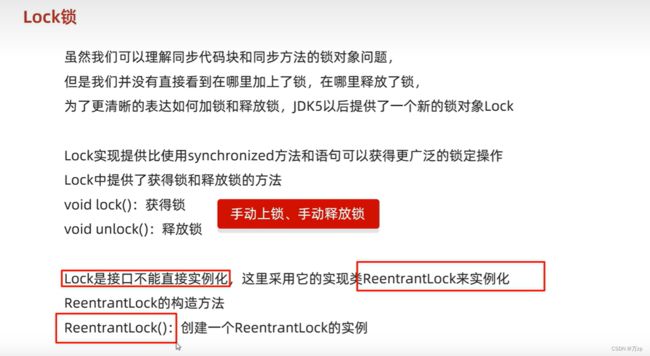java 多线程
01.多线程类java.lang.Thread
这里继承Thread类的方法是比较常用的一种,如果说你只是想起一条线程。没有什么其它特殊的要求,那么可以使用Thread.(笔者推荐使用Runable,后头会说明为什么)。下面来看一个简单的实例:
package com.multithread.learning;
/**
*@functon 多线程学习
*@author 林炳文
*@time 2015.3.9
*/
class Thread1 extends Thread{
private String name;
public Thread1(String name) {
this.name=name;
}
public void run() {
for (int i = 0; i < 5; i++) {
System.out.println(name + "运行 : " + i);
try {
sleep((int) Math.random() * 10);
} catch (InterruptedException e) {
e.printStackTrace();
}
}
}
}
public class Main {
public static void main(String[] args) {
Thread1 mTh1=new Thread1("A");
Thread1 mTh2=new Thread1("B");
mTh1.start();
mTh2.start();
}
}
Thread源码:
public
class Thread implements Runnable {
private volatile String name;
/* What will be run. */
private Runnable target;
public final String getName() {
return name;
}
/**
* Allocates a new {@code Thread} object. This constructor has the same
* effect as {@linkplain #Thread(ThreadGroup,Runnable,String) Thread}
* {@code (null, null, gname)}, where {@code gname} is a newly generated
* name. Automatically generated names are of the form
* {@code "Thread-"+}n, where n is an integer.
*/
public Thread() {
init(null, null, "Thread-" + nextThreadNum(), 0);
}
/**
* Allocates a new {@code Thread} object. This constructor has the same
* effect as {@linkplain #Thread(ThreadGroup,Runnable,String) Thread}
* {@code (null, target, gname)}, where {@code gname} is a newly generated
* name. Automatically generated names are of the form
* {@code "Thread-"+}n, where n is an integer.
*
* @param target
* the object whose {@code run} method is invoked when this thread
* is started. If {@code null}, this classes {@code run} method does
* nothing.
*/
public Thread(Runnable target) {
init(null, target, "Thread-" + nextThreadNum(), 0);
}
@Override
public void run() {
if (target != null) {
target.run();
}
}
}
02、实现java.lang.Runnable接口
采用Runnable也是非常常见的一种,我们只需要重写run方法即可。下面也来看个实例。
/**
*@functon 多线程学习
*@author 林炳文
*@time 2015.3.9
*/
package com.multithread.runnable;
class Thread2 implements Runnable{
private String name;
public Thread2(String name) {
this.name=name;
}
@Override
public void run() {
for (int i = 0; i < 5; i++) {
System.out.println(name + "运行 : " + i);
try {
Thread.sleep((int) Math.random() * 10);
} catch (InterruptedException e) {
e.printStackTrace();
}
}
}
}
public class Main {
public static void main(String[] args) {
new Thread(new Thread2("C")).start();
new Thread(new Thread2("D")).start();
}
}
Runable接口:
@FunctionalInterface
public interface Runnable {
/**
* When an object implementing interface Runnable is used
* to create a thread, starting the thread causes the object's
* run method to be called in that separately executing
* thread.
*
* The general contract of the method run is that it may
* take any action whatsoever.
*
* @see java.lang.Thread#run()
*/
public abstract void run();
}
Callable源码:
@FunctionalInterface
public interface Callable<V> {
/**
* Computes a result, or throws an exception if unable to do so.
*
* @return computed result
* @throws Exception if unable to compute a result
*/
V call() throws Exception;
}
public class MyCallable implements Callable<T> {
@Override
public T call() throws Exception {
// 在这里定义可被调用的代码
}
}
//举个例子,计算总和
public class MyCallable implements Callable<Integer> {
@Override
public Integer call() throws Exception {
// 在这里定义可被调用的代码
int sum =0;
for (int i = 0; i < 100; i++) {
sum+=i;
}
System.out.println(sum);
}
}
public class FutureTask<V> implements RunnableFuture<V> {
private Callable<V> callable;
public FutureTask(Callable<V> callable) {
if (callable == null)
throw new NullPointerException();
this.callable = callable;
this.state = NEW; // ensure visibility of callable
}
}
04.线程状态转换
下面的这个图非常重要!你如果看懂了这个图,那么对于多线程的理解将会更加深刻!
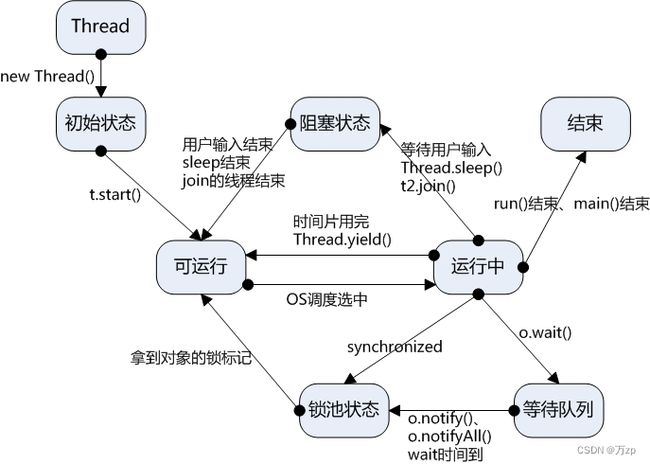
1、新建状态(New):新创建了一个线程对象。
2、就绪状态(Runnable):线程对象创建后,其他线程调用了该对象的start()方法。该状态的线程位于可运行线程池中,变得可运行,等待获取CPU的使用权。
3、运行状态(Running):就绪状态的线程获取了CPU,执行程序代码。
4、阻塞状态(Blocked):阻塞状态是线程因为某种原因放弃CPU使用权,暂时停止运行。直到线程进入就绪状态,才有机会转到运行状态。阻塞的情况分三种:
(一)、等待阻塞:运行的线程执行wait()方法,JVM会把该线程放入等待池中。(wait会释放持有的锁)
(二)、同步阻塞:运行的线程在获取对象的同步锁时,若该同步锁被别的线程占用,则JVM会把该线程放入锁池中。
(三)、其他阻塞:运行的线程执行sleep()或join()方法,或者发出了I/O请求时,JVM会把该线程置为阻塞状态。当sleep()状态超时、join()等待线程终止或者超时、或者I/O处理完毕时,线程重新转入就绪状态。(注意,sleep是不会释放持有的锁)
5、死亡状态(Dead):线程执行完了或者因异常退出了run()方法,该线程结束生命周期。
五、线程调度
线程的调度
1、调整线程优先级:Java线程有优先级,优先级高的线程会获得较多的运行机会。
Java线程的优先级用整数表示,取值范围是1~10,Thread类有以下三个静态常量:
static int MAX_PRIORITY
线程可以具有的最高优先级,取值为10。
static int MIN_PRIORITY
线程可以具有的最低优先级,取值为1。
static int NORM_PRIORITY
分配给线程的默认优先级,取值为5。
Thread类的setPriority()和getPriority()方法分别用来设置和获取线程的优先级。
public final void setPriority(int newPriority) {
ThreadGroup g;
checkAccess();
if (newPriority > MAX_PRIORITY || newPriority < MIN_PRIORITY) {
throw new IllegalArgumentException();
}
if((g = getThreadGroup()) != null) {
if (newPriority > g.getMaxPriority()) {
newPriority = g.getMaxPriority();
}
setPriority0(priority = newPriority);
}
}
/**
* Returns this thread's priority.
*
* @return this thread's priority.
* @see #setPriority
*/
public final int getPriority() {
return priority;
}
每个线程都有默认的优先级。主线程的默认优先级为Thread.NORM_PRIORITY。
线程的优先级有继承关系,比如A线程中创建了B线程,那么B将和A具有相同的优先级。
JVM提供了10个线程优先级,但与常见的操作系统都不能很好的映射。如果希望程序能移植到各个操作系统中,应该仅仅使用Thread类有以下三个静态常量作为优先级,这样能保证同样的优先级采用了同样的调度方式。
都是优先级:五
设置线程优先级
2、线程睡眠:
Thread.sleep(long millis)方法,使线程转到阻塞状态。millis参数设定睡眠的时间,以毫秒为单位。当睡眠结束后,就转为就绪(Runnable)状态。sleep()平台移植性好。
public static native void sleep(long millis) throws InterruptedException;
3、线程等待:
Object类中的wait()方法,导致当前的线程等待,直到其他线程调用此对象的 notify() 方法或 notifyAll() 唤醒方法。这个两个唤醒方法也是Object类中的方法,行为等价于调用 wait(0) 一样。
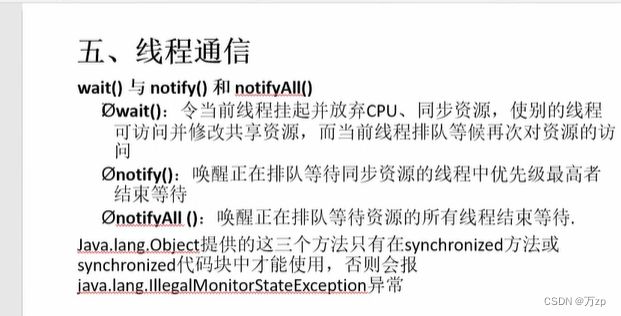
public final void wait(long timeout, int nanos) throws InterruptedException {
if (timeout < 0) {
throw new IllegalArgumentException("timeout value is negative");
}
if (nanos < 0 || nanos > 999999) {
throw new IllegalArgumentException(
"nanosecond timeout value out of range");
}
if (nanos > 0) {
timeout++;
}
wait(timeout);
}
4、线程让步:
Thread.yield() 方法,暂停当前正在执行的线程对象,把执行机会让给相同或者更高优先级的线程。
public static native void yield();
5、线程加入:
join()方法,等待其他线程终止。在当前线程中调用另一个线程的join()方法,则当前线程转入阻塞状态,直到另一个进程运行结束,当前线程再由阻塞转为就绪状态。
public final synchronized void join(long millis)
throws InterruptedException {
long base = System.currentTimeMillis();
long now = 0;
if (millis < 0) {
throw new IllegalArgumentException("timeout value is negative");
}
if (millis == 0) {
while (isAlive()) {
wait(0);
}
} else {
while (isAlive()) {
long delay = millis - now;
if (delay <= 0) {
break;
}
wait(delay);
now = System.currentTimeMillis() - base;
}
}
}
6、线程唤醒:
Object类中的notify()方法,唤醒在此对象监视器上等待的单个线程。如果所有线程都在此对象上等待,则会选择唤醒其中一个线程。选择是任意性的,并在对实现做出决定时发生。
线程通过调用其中一个 wait 方法,在对象的监视器上等待。 直到当前的线程放弃此对象上的锁定,才能继续执行被唤醒的线程。被唤醒的线程将以常规方式与在该对象上主动同步的其他所有线程进行竞争;例如,唤醒的线程在作为锁定此对象的下一个线程方面没有可靠的特权或劣势。类似的方法还有一个notifyAll(),唤醒在此对象监视器上等待的所有线程。
注意:Thread中suspend()和resume()两个方法在JDK1.5中已经废除,不再介绍。因为有死锁倾向。
6.多线程同步
同步:是在一定的时间段内,这个计算机资源只能被这个进程(线程)访问。就像是一种锁。
01.关键字:synchronized
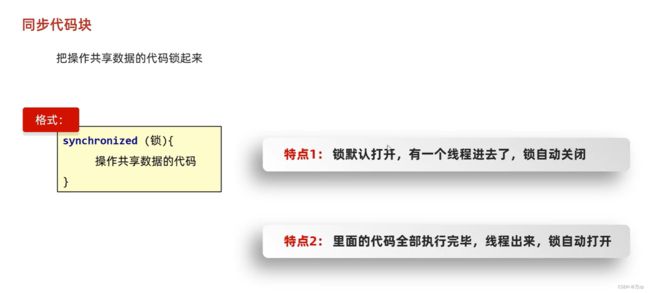
synchronized
不用写出锁对象
